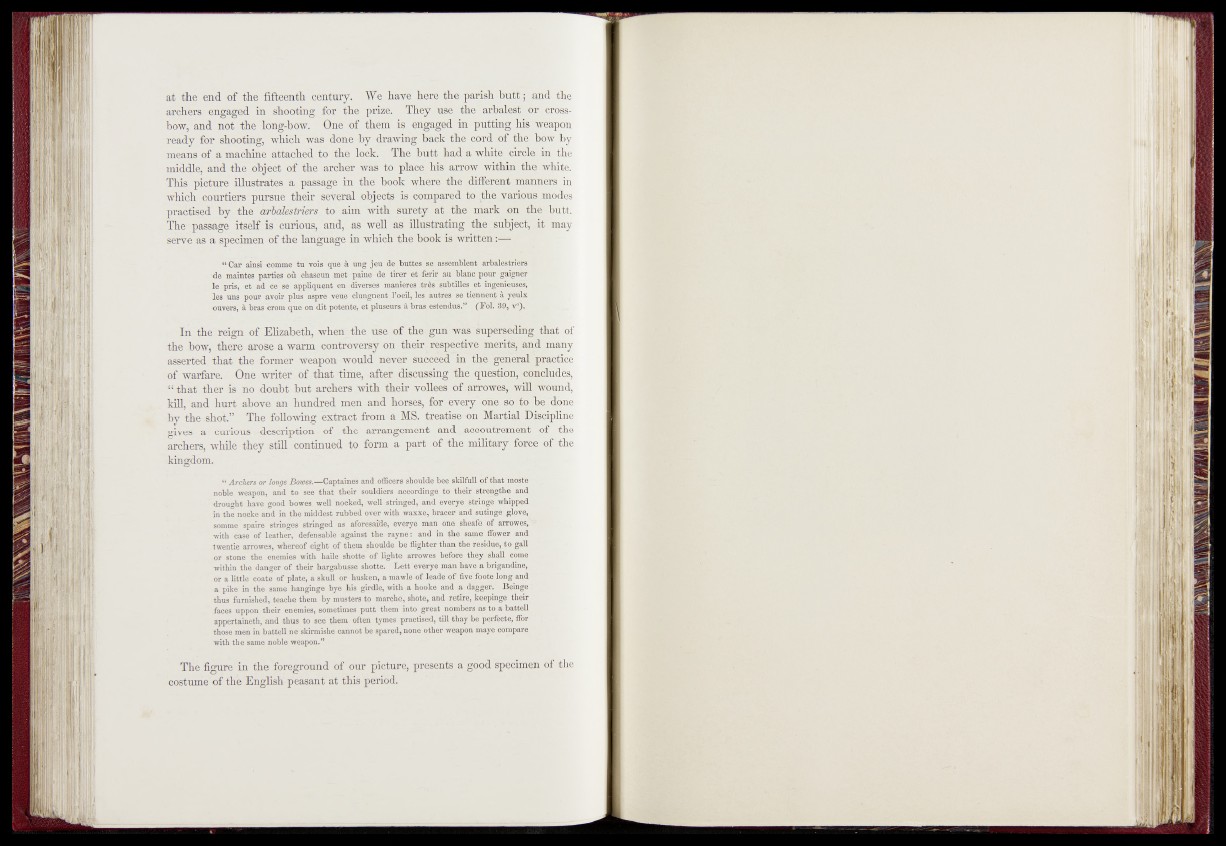
at the end of the fifteenth 'century. We have hèrë th,ë parish butt ; and gfe
archers engaged in shooting for the 'prize. They>nae the arbalest Jjr crossbow,
and not the long-bow. One’'‘of them* is engaged in putting his weapon
ready for shooting, whichTwas dône-By'drawing BabK^the cord of^ 6 ' Bowffig
means of a machine attached to the Jock. 'The butt had a white circle in |S|a
middle, and the object of the archer was to place hisJ arrow within the white.
This picture illustrates a passage in the •bobk' whère the different .manners in
which CQurtierst pursue .their several .object^ is compared to^he .various fcbdes
practised bydthe'àr6aZes^*érs to aim with surety at the mark nh the-Butt.
The ,passage itself.is curious, and, as wéUras illustrating the subject, i t ifiay
Serve as a specimen of thé language in which the bo.® is written ’
“ Car ainsi-comme tu'vois que à- ung jeu de buttes se assemblent arbalestriers
de maintes parties où chasoun met paiue de tirer et Jerir au blaàcfpqur gaigner '
le pris, et ad ce se appliquent en diverses maniérés très subtilleS et .ingénieuses,
les uns pour avoir plus aspre veue clungnent l’oeil, les autres se tiepnen^■ à jyeuls
oUvers, à bras crom quë on dit potent^ et pluseurs t bras estendus.” jÇFoK
In tiiqreign ^Elizabeth, wheff^lhe. use of-t h e | g m w a s , o f
the -bow* there âro&e a warm controversy on Æeirîj^pè^yjÿ'meritty.’and^m&Ly
asserted that the former weapon would never succeed inffl^g.cneralmrràcti cc
o f warfare. One writer of that ttime,-after discussing 4he question, '^Mudes,
‘‘■that ther is no doubt but archers with their vollees of .arrowes, wffl^pund,
Jrilf ‘«rid hurt above an hundred men and horses, for, everVV'<Æe..^Bp >l^qpiKi
by the-shot.” .The following extract from a JÆSr .treatise-on Martial^M-pline
gives a curious -description of the arrangement and^accoutW^iejÆ^fiilht!
archers, while they still continued to form a- part of |the
kingdom.
u Archer* or longe Bovoes.—Captaines and officers sboulde bee skilfull of tEa,t moste -
noble weapon, and to see that their souldiers aecordinge to their strengthe and
" drought have good bowes well nocked, well stringed, and everye. stringe whipped
£ 1 in the nocke and in the middest rubbed over with waxxe, bracer and siitinge glove,
somme spaire stringes stringed as aforesaide, everye man one sheafe of arrowes,
' with ease of leather, defensable against the rayne : and in the same ffower and -
twentie arrowes, whereof eight of them shoulde be flighter than the residue, to gall , :
or stone the enemies with haile shotte of lighte arrowes before they shall come .
within the danger of their hargabusse shotte. Lett everye man have a brigandine,
‘ - or a little coate of plate, a skull or husken, a mawle of leade of five foote long and '
■a pike in the same hangings bye his girdle, with a hooke and a dagger. Bemge :
thus furnished, teache them by musters to marché, shote, and retire, keepings their
faces uppon their enemies, sometimes putt them into great nombers as to a battell
appertained, and thus to see them often tymes practised, till-tliay be perfecte, ffor
those men in battell ne skirmishe cannot be spared, none other weapon maye compare •
with the same noble weapon.”
The figure in the foreground of our picture, presents a good specimen of i$he
costunde'of the English^ peasant at this period.